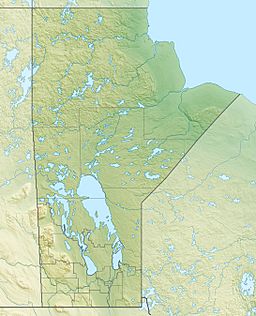Schist Lake (Manitoba) facts for kids
Quick facts for kids Schist Lake |
|
|---|---|
| Manistikwan, Devil's Head Lake | |
| Location | Manitoba, Canada |
| Coordinates | 54°39′N 101°47.5′W / 54.650°N 101.7917°W |
| Type | Glacial |
| Primary inflows | Big Island Creek, Ross Creek |
| Primary outflows | Schist Creek |
| Basin countries | Canada |
| Surface area | 22.6 km2 (8.7 sq mi) |
| Max. depth | 30 m (98 ft) |
Schist Lake is a lake found in Manitoba, Canada. It is located about 3 kilometers southeast of the town of Flin Flon. The lake is quite deep, reaching a maximum depth of 30 meters (about 98 feet).
Schist Lake has four main parts, which are like long sections of the lake. These are called the West Arm, Northwest Arm, Inlet Arm, and Northeast Arm. Water from Schist Lake flows into Lake Athapapuskow through a stream called Schist Creek. This means Schist Lake is part of a much larger water system known as the Nelson River watershed. A watershed is an area of land where all the water drains into a common river or lake.
About Schist Lake
Schist Lake is a beautiful body of water in Manitoba. It is known for its interesting shape with several long arms. These arms help make the lake a great place for different kinds of plants and animals.
Where is Schist Lake?
Schist Lake is in the Canadian province of Manitoba. It is very close to the mining town of Flin Flon. On the northern part of the Northwest Arm of the lake, you can find the Flin Flon/Channing Water Aerodrome. This is a special airport for seaplanes, which are planes that can land and take off from water.
What's in a Name?
The name "Schist Lake" comes from the type of rock found around the lake. This rock is called schist. Schist is a kind of metamorphic rock. Metamorphic rocks are rocks that have changed over time due to heat and pressure deep inside the Earth. The area around the lake is part of the Canadian Shield, which is a very old and large area of rock that covers much of eastern and central Canada.
The lake had a different name a long time ago. It was originally called Manistikiwan. This name comes from the Cree language and means "Devil's Head Lake." Later, this old name was given to a different lake nearby, Big Island Lake.


